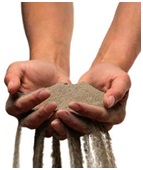A Coaching Power Tool Created by Claire Meurette
(Cross-cultural Coach, FRANCE)
How bringing our ‘inner tortoise’ can support our lives
I wish the days would be longer…
 how many times have you heard someone say that? Most of us actually are or have been there: in that state of extreme “busyness” we often assume is required to live our lives fully and completely. This situation a lot of us found ourselves is often, but not always even encouraged by our cultural environment: the constant demands of getting things done ASAP at work, having to manage a family/household and work and racking our brains to combine extreme scheduling. Even the technology surrounding us encourages us in participating in a fast-paced life which does not leave us much space and time to just breathe and refresh our souls.
how many times have you heard someone say that? Most of us actually are or have been there: in that state of extreme “busyness” we often assume is required to live our lives fully and completely. This situation a lot of us found ourselves is often, but not always even encouraged by our cultural environment: the constant demands of getting things done ASAP at work, having to manage a family/household and work and racking our brains to combine extreme scheduling. Even the technology surrounding us encourages us in participating in a fast-paced life which does not leave us much space and time to just breathe and refresh our souls.
Despite studies showing that historically we work less than ever before and have more time than ever for leisure, a growing number of people are feeling overwhelmed and overloaded.
 The list of consequences of this busy lifestyle is long and non-exhaustive: stress, loss of productivity, burn-out, deterioration of relationships, decrease of creativity and innovations, and a feeling that time is slipping through our fingers like grains of sand, unable to be retained…
The list of consequences of this busy lifestyle is long and non-exhaustive: stress, loss of productivity, burn-out, deterioration of relationships, decrease of creativity and innovations, and a feeling that time is slipping through our fingers like grains of sand, unable to be retained…
How many of us have wondered where their time went after a long busy day?
As Carl Honore, journalist, speaker and advocate of the slow movement puts it
we’re hurrying through our lives, that’s we’re living the fast life instead of the good life.
This tool has been designed to bring out our inner tortoise and support us in living a good life instead of a busy one and and engage ourselves in finding time serenity.
Busyness (noun):
a sign or symptom of engaging in meaningless action
Busyness is highly regarded in many societies starting with Western society. Ambitious men and women are admired and rewarded for their dedicated focus on their careers. Mothers who juggle all their kids’ activities while caring for the home and pursuing an occupation are labeled “supermoms.” Overloaded students who run from school to sports to enrichment activities are promised bright futures for their efforts.
 It seems that we have bought into this world’s value system and hopped on the “busy bandwagon,” hoping to find rich and meaningful lives. But how many of us fall into bed each night completely exhausted, only to get up the next day and start the race all over again? Is this really supporting our lives? Who has never dreamed of taking a day-off just because?
It seems that we have bought into this world’s value system and hopped on the “busy bandwagon,” hoping to find rich and meaningful lives. But how many of us fall into bed each night completely exhausted, only to get up the next day and start the race all over again? Is this really supporting our lives? Who has never dreamed of taking a day-off just because?
People overload their schedules for a variety of reasons, but perhaps the chief one is that we live in a fast-paced culture. There is simply more to do in one day than there is time to do it. Many of us feel overwhelmed by our hectic lifestyles yet don’t know how to slow down. The availability of choices also pushes us in this direction. We want to have it all and quickly.
Some people with driven personalities actually thrive on overcommitment. They find great personal satisfaction in completing each task and are always eager to add more challenges to their day. Every accomplishment gives a sense of purpose and meaning to their lives. Then, there are others who stay busy to avoid dealing with painful experiences. By keeping themselves active, they hope to silence the ache and emptiness within.
This situations is not sustainable in the long term, whether it’s personally or as a society. People who feel overwhelmed at work and at home, and who have the feeling that they are overcommitted during their days will tend to be sicker, more distracted, absent, unproductive and less creative. Recent studies have shown that amongst consequences of the stress induced by this feeling of being overwhelmed are our brains shrinking and lowering our immune system. We get into reacting mode instead of responding to situations that arise in our life. As a society it’s also easy to imagine the consequences of having more people sick, less productive and less innovative.
 Slowing down: bringing out the inner tortoise.
Slowing down: bringing out the inner tortoise.
The richest and the fullest and the fullest lives attempt to achieve an inner balance between three realms: work, love and play Erik Erikson
What does it mean to slow-down?
Slowing-down means to be mindful, taking the time to enjoy what we do at the moment we do it, it also means not to overbook our schedule, to make choices, set up priorities. Slowing down does not mean that we are idle or unproductive. Actually many researches are shown that workers are more productive after talking a 20 minutes walk or nap in the middle of their day.
There are many benefit to slowing down: by slowing down we take the time necessary to make better decisions, we become more creative, less stressed out. Physically we also feel better, more energetic, we’re less sick. Our relationships improve. We fell better about ourselves.
Is there a secret to how to achieve time serenity? Each and everyone of us will have to design their own recipe for time serenity but following are example of ingredients that provide some answers:
Case study:
Consider the following scenario: Amy is an expat and a single mom of two who just moved back to her home country a couple of months before after separating from her long-time partner. On her first coaching session she told her coach that she felt that it was like she was in a “washing machine” and that she wanted it to stop. She was trying to balance a full-time job, a household and the demands of being a full time mom with little help. This worked well for a few months after she had moved back. She had set up clear boundaries for herself at work so she could manage both her full time job and her mommy job. She managed to leave on time most of the days until something changed at work. A new member had joined the team of two she was working in. The new member’s arrival suddenly shaked the foundations of the fragile work/life balance she had managed to achieve. The new member of the team was a woman and a mom too but she was staying long hours and was always volunteering to add on to her workload. Amy soon felt pressured to “deliver” more and started to stay longer hours, having to rely on a baby-sitter to watch her kids. Soon she started to feel overwhelmed, stressed out and tired. At work she started resenting the new member of the team for being that way and her boss for allowing the situation to happen. The atmosphere gradually deteriorated and became tense. As she increased the time she would spend at work she started to feel guilty about not spending enough time with her kids. She would also have less patience with them after coming back from a stressful and long day at work. She had no time to exercise -something that she really enjoyed- and the time she had for herself was fragmented and often “contaminated” by a never-ending to-do list. On weekends she would try to fit what she hadn’t had time to do during the week, house chores like grocery shopping and paying the bills for the house. After only a few weeks she arrived to a breaking point: she wanted to quit her job. Being into that state of extreme busyness did not work for her, it was not supporting the life that she wanted. She did not want to feel rushed all the time, she wanted to have time to read a book with her kids, take a walk, take yoga classes… She wanted to simply slow down and take the time to enjoy things.
The first step for the coach is to listen powerfully to the client. By describing and detailing the situation the client is on its way to more awareness. Awareness can also unearthed through feedback and mirroring the client’s description of his/her life, and powerful questioning.
Here are examples of open-ended questions around this theme:
Once awareness has been brought around the situation and the client has decided to take action it’s time to support him/her in changing the situation by allowing the client to put together an action plan, identify potential roadblocks and find suppport/ressources to sustain the change.
In the case study mentioned above Amy decided that she would be requesting to work part-time and establish clear boundaries at work. She determined that working 4/5 days would work well for her and her kids. It would give her that extra time to take things more slowly and have time for self-care, family time and social life. Her first step was to set-up an appointment with the HR department to clarify the conditions then to talk about it with her boss. She had determined that she wanted to change to happen within the next two months and also decided to surround herself with people who shared the same way to approach work/life balance.
Self-application:
In order to bring out our inner tortoise we need to take a good look at how our life looks like. Keeping a journal of our activities during a standard week and at the end of the week reviewing how we have been spending our time is an example on how to bring awareness about what our time really looks like. Are you satisfied with this picture? Ask yourself if you choose that situation or if you just went along with the way thing went without really thinking about it like a robot. Have you enjoyed this week? Some people only live for weekends, they drag themselves miserably for 5 days until at last the weekend frees them from their time prison. Are you in this case?
Slowing Down vs. Busyness as a Coach:
As a coach is is important to feel energetic and relaxed in order to support our clients the best we can. How can we support our clients if we feel that we have to rush from one coaching session to another without taking the time between session to refresh our souls, replenish our energy and regain our focus? Scheduling a break between back to back sessions allows us to wrap up our first session, letting a safety cushion in case it goes over and prepare for the next one without feeling rushed or/and stressed out. This is just one example of how bringing our inner tortoise as a coach can support our practice and our clients. What are other ways slowing down can support us being better coaches?
Resources:
Carl Honore: “The Slow Fix, Solve problems, work smarter and live better.”
TED TALKS http://www.ted.com/talks/carl_honore_praises_slowness.html
Slow Coaching:
Brigid Schulte “Overwhelmed: Work, Love and Play when none has the time”, March 2014
John Robinson-Jeffrey Godbey “Time for life: the surprising ways Americans use their time”
John Robinson’s 10-Question Time Crunch Scale:
Evaluate the following statements.
1-Strongly Disagree
2-Disagree
3-Agree
4-Strongly Agree
- I often feel under stress when I don’t have enough time
- When I need more time, I tend to cut back on my sleep
- At the end of the day, I often feel that I haven’t accomplished what I set out to do
- I worry that I don’t spend enough time with my family or friends
- I feel that I’m constantly under stress – trying to accomplish more than I can handle
- I feel trapped in a daily routine
- When I’m working long hours, I often feel guilty that I’m not at home
- Sometimes I feel that my spouse doesn’t know who I am anymore
- I consider myself a workaholic
- I just don’t have time for fun anymore